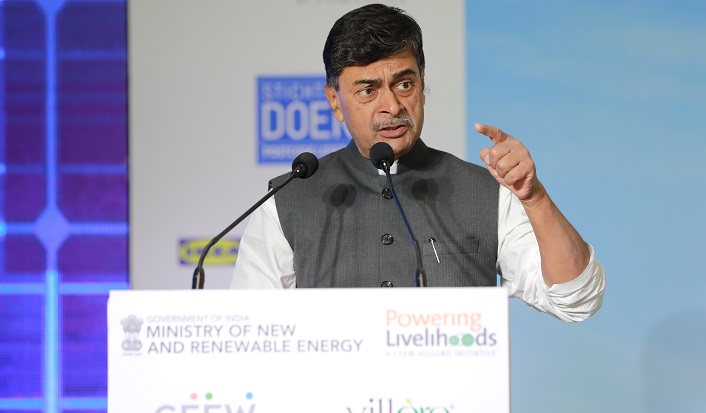Scheme aims to benefit millions of families and create economic opportunities in rural areas
The Indian government is gearing up to announce a new scheme aimed at promoting distributed applications of renewable energy (RE) for livelihoods across the country. The scheme, unveiled by Shri R. K. Singh, Union Minister for Power and New & Renewable Energy, aims to benefit millions of families and stimulate economic growth in rural areas.
During the ‘National Summit on Powering Sustainable Livelihoods’ organized by the Council on Energy, Environment and Water (CEEW) and Villgro Innovations Foundation’s Powering Livelihoods initiative, Minister Singh highlighted the need for large-scale manufacturing and standardization of distributed applications of RE to lower prices and expand the sector. He emphasized that India has already witnessed the potential of grid-scale solar power and will now focus on scaling up distributed applications of renewable energy for livelihoods.
The government plans to make distributed renewable energy (DRE) livelihood equipment more affordable by collaborating with banks to provide financing options for families interested in owning solar dryers and other such technologies. Minister Singh expressed the government’s commitment to scaling up the sector and recognized the pioneering efforts of manufacturers and users of DRE for livelihoods.
To support the announcement, Minister Singh released two reports by CEEW and Villgro, which demonstrated that clean technologies have the potential to impact 37 million livelihoods in India’s agriculture and textile sectors. The reports estimated that the adoption of clean energy technologies could create a market opportunity worth nearly INR 4 lakh crore (approximately USD 50 billion). Additionally, the reports highlighted that 70 percent of women and farmers who used clean technology reported an income increase of around 35 percent, indicating the positive socio-economic impact of clean energy adoption.
As part of the initiative, Shri R. K. Singh also launched ‘Suraj ka Gola,’ a solar anthem produced by CEEW and Villgro. The song, created in collaboration with the band Maati Baani and Ashish Kulkarni of Indian Idol fame, celebrates the transformative power of solar energy in rural India.
The reports further revealed that solar-powered pumps, both higher capacity and micro-pumps, have the highest deployment potential, followed by solar-powered vertical fodder growing units and solar dryers. These four technologies alone have the potential to impact approximately 27 million livelihoods. Solar pumps, in particular, have seen significant growth since government programs supporting them were introduced in 2015.
Abhishek Jain, Fellow and Director of Powering Livelihoods at CEEW, expressed India’s leadership in clean energy transition and highlighted the importance of supporting jobs and livelihoods through initiatives like Powering Livelihoods. Jain emphasized the impact of clean-energy-powered livelihood technologies on enhancing and diversifying people’s incomes, citing the deployment of over 11,000 such technologies across India since the pandemic.
The analysis conducted by CEEW and Villgro identified Uttar Pradesh as the state with the greatest market potential for clean-tech-powered livelihood technologies, followed by West Bengal, Bihar, Gujarat, Maharashtra, Madhya Pradesh, and Karnataka. However, the relative market for each technology varies across states, with micro solar pumps having the highest market potential in West Bengal and solar dryers in Maharashtra.
The reports also highlighted that women make up the majority of clean-tech users, with 74 percent of respondents in a survey conducted across 19 states being women. The deployment of clean technologies has brought about several social impacts as well.
Ananth Aravamundan, Sector Lead for Climate Action at Villgro, emphasized the importance of supporting social entrepreneurs who aim to create livelihood opportunities in rural India through renewable energy. Aravamundan expressed hope that the evidence generated by the Powering Livelihoods program would inspire policymakers, financiers, and manufacturers to extend their support to mainstream such livelihood products.
However, to unlock the full potential of clean tech in rural India, stakeholders must address on-ground challenges such as raw material availability, limited earnings due to poor market linkages, and a lack of service support in rural areas. Stakeholders need to collaborate to commercialize these technologies, provide enhanced capital support to manufacturers, and ensure affordable credit for end-users.
The government’s new scheme for distributed applications of renewable energy demonstrates its commitment to sustainable development, job creation, and improving livelihoods across India. With the potential to impact millions of families and stimulate economic growth, the scheme holds great promise for a cleaner and more prosperous future.
Follow Us on Google News and help us grow – Click for Latest News


